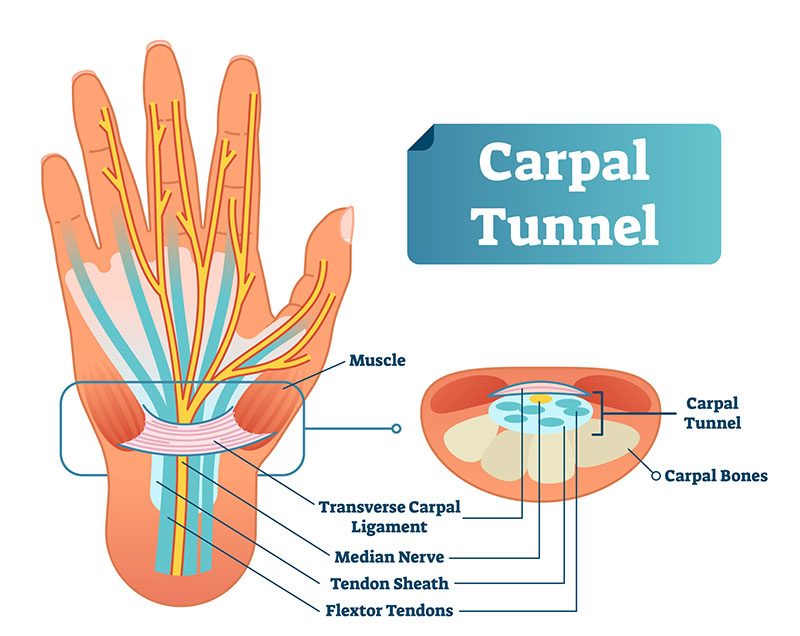I WANT TO LEARN MORE ABOUT ARBILL’S COMPREHENSIVE APPROACH TO SAFETY!
*All fields are required.
After an employee makes a work-related injury claim, the baton is passed to the employer to either accept the claim as a compensable injury, or to contest it. If the employer does not question the existence of the injury itself, the focus then shifts to the causal relationship between the injury and the employee’s job.
Sometimes the causal connection between an injury and employment is obvious, while other injuries or conditions seem to straddle the line between idiopathic and work-related. Falling in that second category of questionable work-related injuries are conditions allegedly caused by repetitive motions of the employee’s body while performing his or her job duties. These injuries are known as cumulative trauma injuries or repetitive stress disorders.

Carpal tunnel syndrome occurs when the median nerve in a person’s wrist becomes entrapped, or pinched, as it travels through a small space in the wrist called the carpal tunnel. The pressure on the median nerve can result in weakness, numbness and tingling in the hand and fingers.
Often, carpal tunnel syndrome can be successfully treated with conservative care, such as rest, temporary modification of duties and/or anti-inflammatory medications. When that is not successful, surgery is frequently performed. The surgery, called a carpal tunnel release, involves cutting the ligament that covers the carpal tunnel which eases the pressure on the median nerve.
Approximately 500,000 Americans undergo a carpal release surgery every year. As you might have guessed, workers’ compensation claimants have a lower success rate following the surgery than the general population. Because carpal tunnel syndrome can leave an employee with permanent restrictions, an employer should be wary of accepting a carpal tunnel syndrome claim as work-related.
Carpal tunnel syndrome has been linked to repetitive use by several medical studies. There are, however, competing studies that conclude that there is no correlation at all between repetitive use and carpal tunnel syndrome. Experts on both sides, however, agree that there are many other causes of carpal tunnel syndrome, aside from repetitive use. The condition can be caused by a single trauma to the wrist or hand, and is often diagnosed after an automobile accident. Other causes include conditions such as hypothyroidism, rheumatoid arthritis, and diabetes. Many times, there is no identifiable cause to the syndrome.
Whether or not a condition like carpal tunnel syndrome is caused by a worker’s employment is an issue often decided by a judge, based upon his or her review of the medical evidence and the physical aspects of the employee’s job. If the claim is denied, and goes to litigation, the employee and his or her expert will need to present evidence to show the repetitive nature of the job and how the duties resulted in damage to the carpal tunnel. The evidence should stress the number of times per day an employee performs an activity in the same postural movement.
On cross-examination of the employee, the employer’s attorney should explore whether the claimant engages in repetitive hand activities outside of work such as playing the piano, woodworking, knitting or similar hobbies. The employer may present fact witnesses to show that the employee’s job is not repetitive and actually involves many physical movements. An investigation of prior injury claims and medical treatment will hopefully show a pre-existing history of carpal tunnel syndrome, thus strengthening a medical defense of the case.
While your employees are not entitled to workers’ compensation benefits for pre-existing injuries, they can make a successful claim for workers’ compensation benefits if they can prove that their current job aggravated a prior injury. An evaluation of the medical records and work history is needed to ascertain whether current carpal tunnel symptoms are really a new aggravation, or just a continuation of the pre-existing condition. If an employee had been diagnosed with carpal tunnel syndrome prior to coming to work at your facility, a thorough investigation will need to be done by you or your insurer prior to making the decision on whether to accept the claim as a distinct new injury.
Most jurisdictions require injured workers to notify their employers of alleged work-related injuries within a certain number of days of the injury. But in repetitive trauma cases, it is difficult to determine the exact “date of injury”. Generally, (although not always), where the medical evidence establishes that ongoing work activities aggravated the condition, the last date of work or the last date on which aggravation occurred is the date of injury. So even though an employee may have been experiencing all the symptoms of carpal tunnel syndrome for many months, the notice period runs from his last date of cumulative trauma, usually the last day of work–and not from the day that he first felt the symptoms, or even the first date of treatment. This can be very frustrating for any employer, who would have taken steps to change the employee’s work activities if it had known that those activities were causing a repetitive injury.
Unlike an injury caused by a single obvious event in the workplace, carpal tunnel syndrome is inherently looked upon with suspicion by employers, and with good reason. The best advice is to promptly report any such claim to your workers’ compensation insurance carrier and get the investigation started. During that time, the employee should be moved to another, less repetitive, job, if possible. If your investigation reveals a number of red flags, encourage your carrier to contest the claim. And if your investigation leads to a conclusion that the diagnosis was caused by the job, look for ways to make the job less repetitive, so as to avoid future claims.
Have a Safe Day!
*All fields are required.